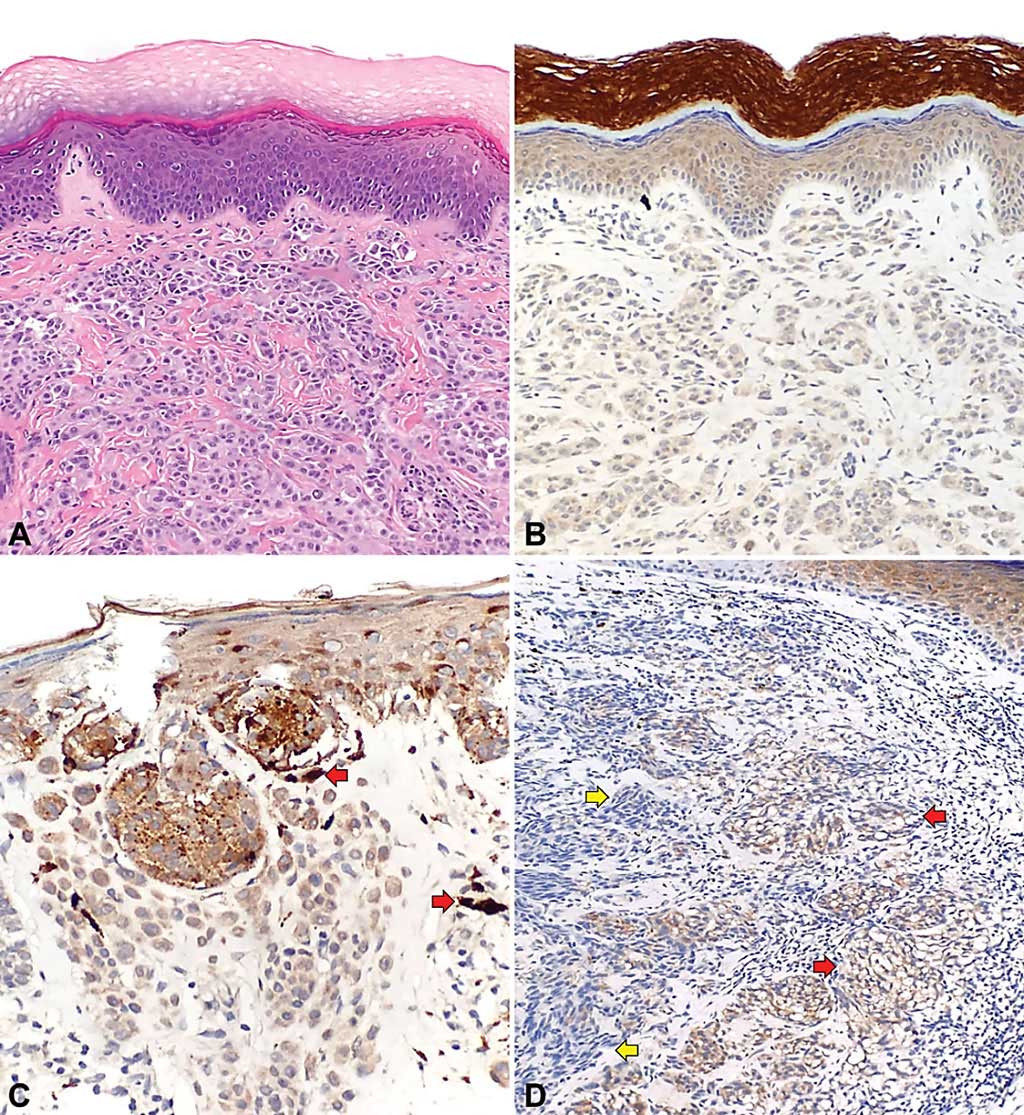Telomerase Reverse Transcriptase Protein Expression Evaluated for Melanomas
|
By LabMedica International staff writers Posted on 19 Jul 2021 |

Image: Telomerase reverse transcriptase (TERT) expression in non-lentiginous acral melanoma (NLAM) and non-acral cutaneous melanoma (NACM): (A) exhibiting 1+ TERT staining intensity and (B) The intensity of TERT expression and proportion of TERT-positive cells could also vary in cutaneous melanomas (Photo courtesy of MD Anderson Cancer Center)
Telomeres are regions of repetitive nucleotide sequences located at the ends of chromosomes that play a key role in the maintenance of genomic integrity and stability in cells. In normal nonneoplastic somatic cells, telomeres progressively shorten with successive cell divisions.
Molecularly distinct from cutaneous melanomas arising from sun-exposed sites, acral lentiginous melanomas (ALMs) typically lack ultraviolet-signature mutations, such as telomerase reverse transcriptase (TERT) promoter mutations. Instead, ALMs show a high degree of copy number alterations, often with multiple amplifications of TERT, which are associated with adverse prognosis.
Pathologists at the University of Texas MD Anderson Cancer Center (Houston, TX, USA) identified a total of 57 cases of acral and non-acral melanocytic lesions, including 24 primary ALMs, six metastatic ALMs, 10 primary non-lentiginous acral melanomas (NLAMs), 12 primary NACMs, and five acral nevi (AN), diagnosed at their institution between 2003 and 2016. Demographic, clinical, and histopathologic parameters and follow-up data for the selected cases were retrieved through review of the final pathology reports and clinical charts.
Immunohistochemical (IHC) analysis of TERT protein expression was performed on a 5-μm–thick paraffin section was cut from each tissue block of selected cases. The paraffin sections were then tested for TERT protein expression by IHC using an anti-TERT monoclonal rabbit anti-human antibody (Abcam, Cambridge, MA, USA) performed on a Leica Bond autostainer (Leica Biosystems, Buffalo Grove, IL, USA) per routine laboratory protocols. The pattern of TERT protein expression was recorded as negative, cytoplasmic, nuclear, or Golgi/perinuclear.
The investigators reported that TERT expression was more frequent in ALMs than in non-lentiginous acral melanomas and non-acral cutaneous melanomas, and was absent in acral nevi. When present, TERT expression in ALMs was cytoplasmic and more intense than TERT expression in other melanocytic lesions (with a higher H-score). There was a trend toward decreased overall survival in patients with ALMs with TERT immunoreactivity, but it did not reach statistical significance. Furthermore, no correlation was found between TERT expression and disease-specific survival in patients with ALMs.
The authors concluded that their study demonstrated that unlike TERT promoter mutations, TERT protein expression was frequently detected in both primary and metastatic ALMs. In addition, the study was the first to demonstrate differences in TERT immunohistochemical expression between ALMs and NLAMs, which have never been separately studied but rather have been grouped together (i.e., as “acral melanomas”) without histologic distinction. Lastly, in their study, although TERT expression was more frequent and of stronger intensity in ALMs than in other types of melanocytic lesions, with higher overall H-scores, TERT immunoreactivity in ALMs did not correlate with survival. The study was published in the July 2021 issue of the journal Archives of Pathology and Laboratory Medicine.
Related Links:
University of Texas MD Anderson Cancer Center
Abcam
Leica Biosystems
Molecularly distinct from cutaneous melanomas arising from sun-exposed sites, acral lentiginous melanomas (ALMs) typically lack ultraviolet-signature mutations, such as telomerase reverse transcriptase (TERT) promoter mutations. Instead, ALMs show a high degree of copy number alterations, often with multiple amplifications of TERT, which are associated with adverse prognosis.
Pathologists at the University of Texas MD Anderson Cancer Center (Houston, TX, USA) identified a total of 57 cases of acral and non-acral melanocytic lesions, including 24 primary ALMs, six metastatic ALMs, 10 primary non-lentiginous acral melanomas (NLAMs), 12 primary NACMs, and five acral nevi (AN), diagnosed at their institution between 2003 and 2016. Demographic, clinical, and histopathologic parameters and follow-up data for the selected cases were retrieved through review of the final pathology reports and clinical charts.
Immunohistochemical (IHC) analysis of TERT protein expression was performed on a 5-μm–thick paraffin section was cut from each tissue block of selected cases. The paraffin sections were then tested for TERT protein expression by IHC using an anti-TERT monoclonal rabbit anti-human antibody (Abcam, Cambridge, MA, USA) performed on a Leica Bond autostainer (Leica Biosystems, Buffalo Grove, IL, USA) per routine laboratory protocols. The pattern of TERT protein expression was recorded as negative, cytoplasmic, nuclear, or Golgi/perinuclear.
The investigators reported that TERT expression was more frequent in ALMs than in non-lentiginous acral melanomas and non-acral cutaneous melanomas, and was absent in acral nevi. When present, TERT expression in ALMs was cytoplasmic and more intense than TERT expression in other melanocytic lesions (with a higher H-score). There was a trend toward decreased overall survival in patients with ALMs with TERT immunoreactivity, but it did not reach statistical significance. Furthermore, no correlation was found between TERT expression and disease-specific survival in patients with ALMs.
The authors concluded that their study demonstrated that unlike TERT promoter mutations, TERT protein expression was frequently detected in both primary and metastatic ALMs. In addition, the study was the first to demonstrate differences in TERT immunohistochemical expression between ALMs and NLAMs, which have never been separately studied but rather have been grouped together (i.e., as “acral melanomas”) without histologic distinction. Lastly, in their study, although TERT expression was more frequent and of stronger intensity in ALMs than in other types of melanocytic lesions, with higher overall H-scores, TERT immunoreactivity in ALMs did not correlate with survival. The study was published in the July 2021 issue of the journal Archives of Pathology and Laboratory Medicine.
Related Links:
University of Texas MD Anderson Cancer Center
Abcam
Leica Biosystems
Latest Pathology News
- AI Tool Simultaneously Identifies Genetic Mutations and Disease Type
- Rapid Low-Cost Tests Can Prevent Child Deaths from Contaminated Medicinal Syrups
- Tumor Signals in Saliva and Blood Enable Non-Invasive Monitoring of Head and Neck Cancer
- Common Health Issues Can Influence New Blood Tests for Alzheimer’s Disease
- Blood Test Formula Identifies Chronic Liver Disease Patients with Higher Cancer Risk
- Tunable Cell-Sorting Device Holds Potential for Multiple Biomedical Applications
- AI Tool Outperforms Doctors in Spotting Blood Cell Abnormalities
- AI Tool Rapidly Analyzes Complex Cancer Images for Personalized Treatment
- Diagnostic Technology Performs Rapid Biofluid Analysis Using Single Droplet
- Novel Technology Tracks Hidden Cancer Cells Faster
- AI Tool Improves Breast Cancer Detection
- AI Tool Predicts Treatment Success in Rectal Cancer Patients
- Blood Test and Sputum Analysis Predict Acute COPD Exacerbation
- AI Tool to Transform Skin Cancer Detection with Near-Perfect Accuracy
- Unique Immune Signatures Distinguish Rare Autoimmune Condition from Multiple Sclerosis
- Simple Optical Microscopy Method Reveals Hidden Structures in Remarkable Detail
Channels
Clinical Chemistry
view channel
Noninvasive Blood-Glucose Monitoring to Replace Finger Pricks for Diabetics
People with diabetes often need to measure their blood glucose multiple times a day, most commonly through finger-prick blood tests or implanted sensors. These methods can be painful, inconvenient, and... Read more
POC Breath Diagnostic System to Detect Pneumonia-Causing Pathogens
Pseudomonas aeruginosa is a major cause of hospital-acquired and ventilator-associated pneumonia, particularly in lung transplant recipients and patients with structural lung disease. Its ability to form... Read moreMolecular Diagnostics
view channel
Endometriosis Blood Test Could Replace Invasive Laparoscopic Diagnosis
Endometriosis affects an estimated 1 in 10 women globally, yet diagnosis can take 7 to 10 years on average due to the invasive nature of laparoscopy and lack of accurate, non-invasive tests.... Read more
World's First NGS-Based Diagnostic Platform Fully Automates Sample-To-Result Process Within Single Device
Rapid point-of-need diagnostics are of critical need, especially in the areas of infectious disease and cancer testing and monitoring. Now, a direct-from-specimen platform that performs genomic analysis... Read more
Rapid Diagnostic Breakthrough Simultaneously Detects Resistance and Virulence in Klebsiella Pneumoniae
Antibiotic resistance is a steadily escalating threat to global healthcare, making common infections harder to treat and increasing the risk of severe complications. One of the most concerning pathogens... Read moreHematology
view channel
MRD Tests Could Predict Survival in Leukemia Patients
Acute myeloid leukemia is an aggressive blood cancer that disrupts normal blood cell production and often relapses even after intensive treatment. Clinicians currently lack early, reliable markers to predict... Read more
Platelet Activity Blood Test in Middle Age Could Identify Early Alzheimer’s Risk
Early detection of Alzheimer’s disease remains one of the biggest unmet needs in neurology, particularly because the biological changes underlying the disorder begin decades before memory symptoms appear.... Read more
Microvesicles Measurement Could Detect Vascular Injury in Sickle Cell Disease Patients
Assessing disease severity in sickle cell disease (SCD) remains challenging, especially when trying to predict hemolysis, vascular injury, and risk of complications such as vaso-occlusive crises.... Read more
ADLM’s New Coagulation Testing Guidance to Improve Care for Patients on Blood Thinners
Direct oral anticoagulants (DOACs) are one of the most common types of blood thinners. Patients take them to prevent a host of complications that could arise from blood clotting, including stroke, deep... Read moreImmunology
view channel
Ultrasensitive Liquid Biopsy Demonstrates Efficacy in Predicting Immunotherapy Response
Immunotherapy has transformed cancer treatment, but only a small proportion of patients experience lasting benefit, with response rates often remaining between 10% and 20%. Clinicians currently lack reliable... Read more
Blood Test Could Identify Colon Cancer Patients to Benefit from NSAIDs
Colon cancer remains a major cause of cancer-related illness, with many patients facing relapse even after surgery and chemotherapy. Up to 40% of people with stage III disease experience recurrence, highlighting... Read moreMicrobiology
view channel
New UTI Diagnosis Method Delivers Antibiotic Resistance Results 24 Hours Earlier
Urinary tract infections affect around 152 million people every year, making them one of the most common bacterial infections worldwide. In routine medical practice, diagnosis often relies on rapid urine... Read more
Breakthroughs in Microbial Analysis to Enhance Disease Prediction
Microorganisms shape human health, ecosystems, and the planet’s climate, yet identifying them and understanding how they are related remains a major scientific challenge. Even with modern DNA sequencing,... Read moreTechnology
view channel
AI Predicts Colorectal Cancer Survival Using Clinical and Molecular Features
Colorectal cancer is one of the most common and deadly cancers worldwide, and accurately predicting patient survival remains a major clinical challenge. Traditional prognostic tools often rely on either... Read more
Diagnostic Chip Monitors Chemotherapy Effectiveness for Brain Cancer
Glioblastoma is one of the most aggressive and fatal brain cancers, with most patients surviving less than two years after diagnosis. Treatment is particularly challenging because the tumor infiltrates... Read moreIndustry
view channel
BD and Penn Institute Collaborate to Advance Immunotherapy through Flow Cytometry
BD (Becton, Dickinson and Company, Franklin Lakes, NJ, USA) has entered into a strategic collaboration with the Institute for Immunology and Immune Health (I3H, Philadelphia, PA, USA) at the University... Read more




















